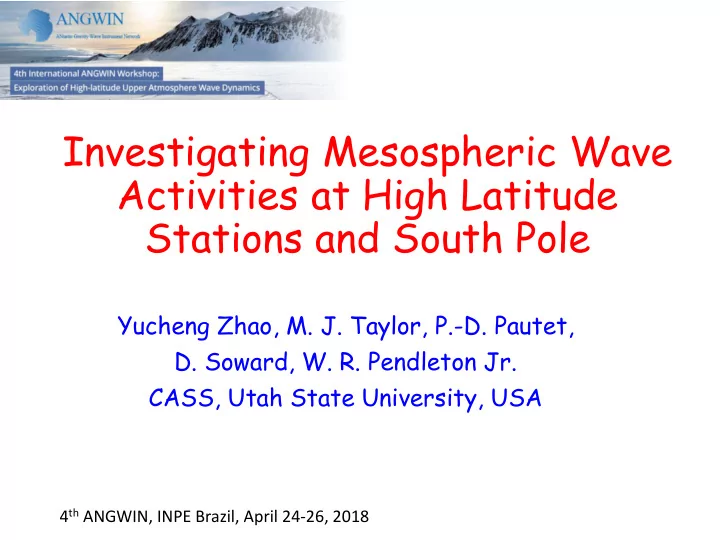

Investigating Mesospheric Wave Activities at High Latitude Stations and South Pole Yucheng Zhao, M. J. Taylor, P.-D. Pautet, D. Soward, W. R. Pendleton Jr. CASS, Utah State University, USA 4 th ANGWIN, INPE Brazil, April 24-26, 2018
High-Latitude Research Using an Advanced Mesospheric Temperature Mapper (AMTM) • The AMTM sequentially observes selected emission lines in the OH (3,1) band to derive high-quality temperature maps @ ~85 km. • Temperature precision/pix ~2 K in 30 sec. • High-latitude capability as emission lines avoid auroral contamination. • 2 AMTM operational since 2011: ALOMAR, Northern Norway (69.3 ° N), and at South Pole (90 ° S) Antarctica. • 3 rd AMTM installed at McMurdo station (78 ° S) 2017. • Oct 2017, one of the AMTMs was relocated from ALOMAR to Poker Flat Research Range (65 ° N) AMTM at South Pole
AMTM Temperature Map • Zenith temperature (20x20 central pixels)
Daily Temperature Measurements temperature >2,500 data pts/24 hours
High latitude Sites: South and North Poker Flat (65°N) South Pole (90ºS) McMurdo (78°S)
Sites and Data McMurdo PFRR ALOMAR South Pole Latitude 69.3 ° N 90 ° S 78 ° S 65 ° N Season starting Oct 1 April 19 March 21 Nov. 1 date (2017) Season ending September April April 15 August 31 date 30 Season 6.5 Months 4.5 months >6 months ~6 months duration Daily data longest Mostly 24 Some 24 ~16 hours duration hours ~16-17 hours hours
Winter Season Daily Mean Temperatures South Pole 2012 ALOMAR 2012-13 240 240 230 230 Temperature (K) 220 220 Temperature (K) 210 210 200 200 190 190 212.7 ± 10 K 211.0 ±12 K 180 180 Oct Nov Dec Jan Feb Mar Apr Apr May Jun Jul Aug Poker Flat 2017-18 McMurdo 2017 240 240 230 230 Temperature (K) Temperature (K) 220 220 210 210 200 200 190 190 205.5 ± 8 K 180 214.3 ± 10 K 180 170 60 120 180 240 300 Nov Dec Jan Feb Mar Date
The Major Sudden Stratospheric Warming (SSW): 12 February 2018 Kaoru Sato: 2nd Information related to ICSOM-3 and request of data
Planetary Wave Activities South Pole ALOMAR 4000 18 day 40 days Normalized Power 3000 45 day 5 day 14 days 2000 28day 1000 0 0 10 20 30 40 50 60 70 80 Period (day) • Rich spectrum from both sites • Planetary waves with different periods were observed
Planetary Wave Activities McMurdo, 2017 Poker Flat, 2017-18 5000 6000 Normalized Power 5000 4000 Normalized Power 4000 3000 3000 2000 2000 1000 1000 0 0 0 10 20 30 40 50 0 10 20 30 40 50 60 Period (day) Period (day)
Mesospheric Planetary Waves Observed at South Pole 2012
Planetary Wave Activities at ALOMAR (a year later) South Pole 2014 ALOMAR 2015-2016 230 240 220 Temperature (K) Temperature (K) 210 220 200 190 200 180 170 180 160 90 120 150 180 210 240 Oct Dec Jan Mar Date Similar wave was observed during the 2015-16 winter season at ALOMAR. Period~ 23 days
The PW Mike and Dominique Mentioned: McMurdo 2017: the return of the 28 day Rossby wave?
Gravity Wave/Tide Spectrum 1500 600 ALOMAR 2012-2013 2012 Normalized Power South Pole Normalized Power 1000 400 500 200 0 0 0 6 12 18 24 0 6 12 18 24 period (hr) Period (hour) • ALOMAR: • Strong semidiurnal tides • Gravity waves 3-10 hours • South pole: • No/very weak tides • Strong gravity wave activities with periods 4-10 hours
GW/Tidal spectrum at PFRR and McMurdo Poker Flat, 2017-18 McMurdo 2017 2000 1000 Normalized Power Normalized Power 800 1500 600 1000 400 500 200 0 0 0 6 12 18 24 0 6 12 18 24 Period (hour) Period (hour) • Similar GW spectrum • Clear tidal signature at Poker Flat
The Mid-Latitude GW Activities (Chile, 30ºS) Gravity wave energy peaked in the middle of each winter season.
Daily Temperature Variance (GW activities) South Pole ALOMAR 50 70 Temperature Variance (K 2 ) Temperature Variance (K 2 ) 60 40 50 30 40 30 20 20 10 10 Oct 0 0 Dec Feb Mar Nov Jan Apr 120 150 180 210 240 Date The variance from both sites are of similar values ALOMAR: wave energy decreased South Pole: wave energy increased Yoshiki and Sato (2000): gravity wave energy peaked in spring in the stratosphere (SH)
Daily Temperature Variance (GW activities) McMurdo 2017 Poker Flat 2017-18 Temperature Variance (K 2 ) 60 50 Temperature Variance (K 2 ) 50 40 40 30 30 20 20 10 10 0 0 300 330 360 390 420 450 120 180 240 Date Date
Multi-Year: South Pole vs. ALOMAR South Pole ALOMAR Temperature Variance (K 2 ) Temperature Variance (K 2 ) 2011 2013-14 40 40 2012 2014-15 2013 2012-13 2014 30 30 20 20 10 10 0 Oct Dec Feb Apr 120 150 180 210 240 Date
Summary • Winter time mesospheric temperature data from four unique sites, ALOMAR, PFRR, McMurdo and South Pole stations, showed similarities and differences during winter seasons. • Similar winter time mean temperature for all stations but clear decrease through the winter for 3 stations other than PFRR which showed SSW signature in Feb. • Different planetary waves were observed from all sites and year-to-year variability in planetary wave activities for South Pole and ALOMAR. • Short-period gravity wave spectrum are similar. However, strong semi- diurnal tides were observed at 3 high latitude stations, while no/weak tidal signatures at South Pole during winter season. • During the winter season, gravity wave energy increased at South Pole. • The other three high latitude stations, wave energy peaked in the middle of the winter season except for 2012-13 season at ALOMAR where the wave energy decreased through the winter. • Questions: What contribute to the change of the GW energy variation during the winter season? Lower atmospheric sources, filtering conditions?
Recommend
More recommend